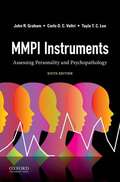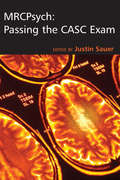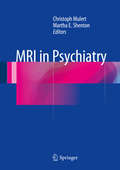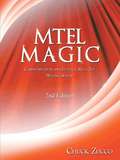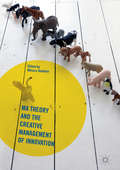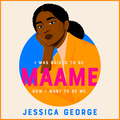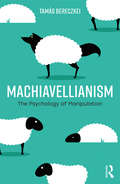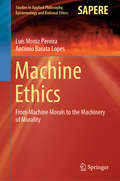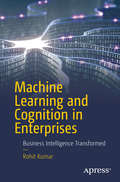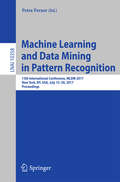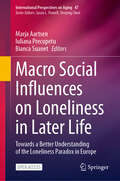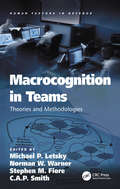- Table View
- List View
MMPI Instruments: Assessing Personality and Psychopathology
by John R. Graham Carlo O. C. Veltri Tayla T. C. LeeMMPI Instruments: Assessing Personality and Psychopathology 6th edition provides a bridge for graduate students and clinicians alike in navigating the changes and updates to the MMPI, including the recently released MMPI-3. <p><p>The Minnesota Multiphasic Personality Inventory (MMPI) family of instruments are the most widely used tests of personality and psychopathology in the United States and are commonly used in countries around the world. They are used in inpatient and outpatient mental health settings, medical centers, and correctional settings. MMPI instruments are also used in the screening of applicants for jobs that involve public trust and safety. They are frequently admitted as evidence in civil and criminal legal proceedings.
MMPI-2: Assessing Personality and Psychopathology
by John R. Graham<P>The MMPI-2 is the most widely used personality test in the U.S. and around the world. It is employed in mental health settings, medical centers, and correctional programs, and is frequently admitted as evidence in legal proceedings. In addition, the MMPI-2 is widely used in screening applicants for jobs that involve public trust and safety. The fifth edition of MMPI-2: Assessing Personality and Psychopathology describes effective uses of all aspects of the MMPI-2 and explains how to accurately interpret test results. Current and comprehensive, it presents detailed instructions for administering and scoring the MMPI-2 and discusses using the MMPI-2 with such diverse population groups as older adults, ethnic minorities, medical patients, and prisoners. It provides guidelines for interpreting the test's Validity, Clinical Content, and Supplementary scales, illustrating points with case studies and examples. The book also covers the Restructured Clinical (RC) scales, which help focus the interpretation of the original Clinical scales, and the Personality Psychopathology 5 (PSY-5) scales, which assess major dimensions of normal and abnormal personality. <P>NEW TO THIS EDITION BL A chapter detailing the development and use of the newest form of the test, the MMPI-2 Restructured Form (MMPI-2-RF) BL A reintroduction of a chapter covering the adolescent version of the test, the MMPI-A, including updated research findings and recommendations for interpretation MMPI-2: Assessing Personality and Psychopathology, Fifth Edition, is ideal for graduate courses in psychological assessment and is an indispensable guide for researchers and clinicians working in the personality assessment area.
MMPI-A Casebook
by Robert P. Archer Radhika Krishnamurthy Jody M. JacobsonThe purpose of this volume is to provide the MMPI-A user with a series of clinical case examples that illustrate salient principles involved in the interpretation of MMPI-A profiles. This volume is focused specifically on interpretation issue, and assumes that the reader is familiar with the literature on the development and psychometric properties of the MMPI-A as presented in the test manual (Butcher, Williams, Graham, Archer, Tellegen, Ben-Porath, & Kemmer, 1992) and interpretive guides to the MMPI-A (Archer, 1992a; Butcher & Williams, 1992).
MRC Psych Part 1 In a Box
by Bhaskar Punukollu MBBS MRCPsych Michael Phelan BSc MBBS MRCPsych Anish Unadkat BMBS BmedsciExam-specific question and answer cards, using standard question formats from the Royal College exams, these cards make exam preparation time as efficient and straightforward as possible. They also lend. themselves studying with a partner or colleague. They are aimed specifically at candidates taking the first part of the examination for the Membership of the Royal College of Psychiatrists (MRCPsych Part 1) and provide a condensed review of highly relevant information for the exam. Key areas covered are Psychopathology; neuroscience; neurotic, stress related and somatoform disorders; schizophrenia and other psychoses; affective disorders; psycho-pharmacology; psychology; psychotherapy; and dementia syndromes. The first nine sections of cards are broadly divided into commonly tested areas on the exam: 1. Neurotic disorders 2. Affective disorders 3. Dementia syndromes 4. Neuropsychiatry 5. Psychology 6. Psychotherapy 7. Schizophrenia 8. Pharmacology 9. Human development
MRCPsych: Passing the CASC Exam
by Justin SauerA newly-prepared revision guide tailored to the brand new Clinical Assessment of Skills and Competencies (CASC) portion of the MRCPsych exam, containing over 100 clinical scenarios and accompanied by the ideal 'answers' examiners will be looking for.
MRCPsych: Passing the CASC Exam, Second Edition
by Justin Sauer Malarvizhi B. SandilyanThis is a fully-updated, comprehensive guide for trainees preparing for the MRCPsych CASC exam (Clinical Assessment of Skills and Competencies). Success in the CASC is the final step in being awarded the MRCPsych qualification, which signifies the physician has fulfilled the necessary training requirements and has passed the membership exams conducted by the Royal College of Psychiatrists. The book is presented in a clear layout and covers the full range of psychiatry subspecialties likely to be encountered on exam day.
MRI in Psychiatry
by Martha E. Shenton Christoph MulertThis is the first comprehensive textbook on the use of MRI in psychiatry covering imaging techniques, brain systems and a review of findings in different psychiatric disorders. The book is divided into three sections, the first of which covers in detail all the major MRI-based methodological approaches available today, including fMRI, EEG-fMRI, DTI and MR spectroscopy. In addition, the role of MRI in imaging genetics and combined brain stimulation and imaging is carefully explained. The second section provides an overview of the different brain systems that are relevant for psychiatric disorders, including the systems for perception, emotion, cognition and reward. The final part of the book presents the MRI findings that are obtained in all the major psychiatric disorders using the previously discussed techniques. Numerous carefully chosen images support the informative text, making this an ideal reference work for all practitioners and trainees with an interest in this flourishing field.
MTEL Magic: Writing Subtest
by Chuck ZuccoThe name of this book is a misnomer. There really is no magical solution to taking this or any other test. What makes this book different is that it presents a simple formula for passing-skills + strategies + practice = success.
Ma Theory and the Creative Management of Innovation
by Mitsuru KodamaThis book focuses on the core theoretical concept of "Ma thinking" - an idea that serves as springboard for the thoughts and actions of distinguished practitioners, innovators, and researchers. The theoretical and practical importance of the Ma concept in new innovation activities lies in the thinking and activities of the leading practitioners. However, there is little academic research clarifying these characteristic dynamic transition mechanisms and the synthesis of diverse paradoxes through recursive activities between formal and informal organizations to achieve integration of dissimilar knowledge.
Maame: The unique, unfiltered, unforgettable must-read debut of 2023
by Jessica GeorgeTHE debut of 2023. A blisteringly funny, heartbreaking novel about twenty-something British Ghanaian Maddie as she grapples with identity, love, loss, and becoming the woman she wants to be - for fans of Chewing Gum, Such a Fun Age and Queenie***Mum calls me Maame. It has many meanings in Twi, but in my case, it means woman.Meet Maddie.To her mostly-absent mum, she's Maame, the woman of the family. To her dad, she's his carer - even if he hardly recognises her. To her friends, she's the one who still lives at home, who never puts herself first.It's time to become the woman she wants to be.The kind who wears a bright yellow suit, says yes to after-work drinks and flirts with a thirty-something banker. Who doesn't have to google all her life choices. Who demands a seat at the table.But to put ourselves together, sometimes we have to fall apart...Heartbreaking, sharply funny and achingly relatable, Maame is an irresistibly fresh coming-of-age story with a heroine you'll never forget.'Honest, warm, heart-breaking and heart-healing. It felt truly modern, yet somehow timeless. I adored it'Nikki May, author of WAHALA'A poignant coming-of-age tale about finding strength, hope and courage . . . Maame's quiet confidence is true to life and liberating'Lizzie Damilola Blackburn, author of Yinka, Where is your Huzband?(P)2023 Hodder & Stoughton Limited
Machen MOOCs Karriere?: Eine praxisnahe Reflexion über Erfahrungen von Unternehmen
by Christian Friedl Markus DeimannImmer mehr Unternehmen entdecken Massive Open Online Courses, kurz: MOOCs als Format für Aus- und Weiterbildung, Training, Rekrutierung und Onboarding. Sind MOOCs ein valides Modell für eine zukunftsfähige, betriebliche Weiterbildung? Können sie die formale Wissensvermittlung in Form von Seminaren, Kursen und Web-based Trainings ergänzen? Bieten sie Möglichkeiten, um Mitarbeiter mit sich ändernden Bedürfnissen und ihre Erfahrungen über dieses Format zu mobilisieren und zu skalieren?Dieses Buch bietet einen praxisnahen Überblick zu Vorreitern im deutschsprachigen RaumUnternehmen wie die Credit Suisse, Telekom, SAP, Audi, Erste Bank und andere haben bereits interne MOOCs durchgeführt und teilen ihre Erfahrungen mit den Lesern. Die Beiträge bieten unterschiedliche Einblicke, etwa wie ein Firmeninternes soziales Netzwerk in eine Lern-Community umgewandelt wurde, wie Ausbildungsverantwortliche und Fachtrainer auf eine MOOC-Lernreise geschickt wurden und wie unterschiedliche didaktische Ansätze probiert und reflektiert wurden. Darauf aufbauend wird ein Ausblick auf aktuelle Trends und Entwicklungen in diesem Feld angestellt.
Machiavelli: Bullet Guides
by Robert AndersonOpen this book and you will - learn about Machiavelli's life - know his key works - explore the dark arts of politics - assess his influence
Machiavellianism: The Psychology of Manipulation
by Tamás BereczkeiThe world abounds with tricksters, swindlers, and impostors. Many of them may well be described with the term Machiavellian. Such individuals disrespect moral principles, deceive their fellow beings, and take advantage of others’ frailty and gullibility. They have a penetrating, rational, and sober mind undisturbed by emotions. At times we cannot help but be enchanted by their talent even though we know they misuse it. <P><P> Recent studies have revealed that Machiavellians possess a complex set of abilities and motivations. This insightful book examines the complexities of the Machiavellian trait, in relation to attitude, behaviour, and personality. By integrating results and experiences from social, personality, cognitive, and evolutionary psychology, Tamás Bereczkei explores the characteristics of Machiavellianism (such as social intelligence, deception, manipulation, and lack of empathy), and the causes and motives guiding Machiavellian behaviour. The author also demonstrates how Machiavellianism is related to strategic thinking and flexible long-term decisions rather than to a short-term perspective, as previously thought, and explores Machiavellianism in relation to the construct of the Dark Triad. <P><P> The first comprehensive psychological book on Machiavellianism since Christie and Geis’ pioneering work in 1970, Machiavellianism summarises the most important research findings over the last few decades. This book is fascinating reading for students and researchers of psychology and related courses, as well as professionals dealing with Machiavellians in their work and practice.
Machine Ethics: From Machine Morals to the Machinery of Morality (Studies in Applied Philosophy, Epistemology and Rational Ethics #53)
by Luís Moniz Pereira António Barata LopesThis book offers the first systematic guide to machine ethics, bridging between computer science, social sciences and philosophy. Based on a dialogue between an AI scientist and a novelist philosopher, the book discusses important findings on which moral values machines can be taught and how. In turn, it investigates what kind of artificial intelligence (AI) people do actually want. What are the main consequences of the integration of AI in people’s every-day life? In order to co-exist and collaborate with humans, machines need morality, but which moral values should we teach them? Moreover, how can we implement benevolent AI? These are just some of the questions carefully examined in the book, which offers a comprehensive account of ethical issues concerning AI, on the one hand, and a timely snapshot of the power and potential benefits of this technology on the other. Starting with an introduction to common-sense ethical principles, the book then guides the reader, helping them develop and understand more complex ethical concerns and placing them in a larger, technological context. The book makes these topics accessible to a non-expert audience, while also offering alternative reading pathways to inspire more specialized readers.
Machine Learning and Cognition in Enterprises
by Rohit KumarLearn about the emergence and evolution of IT in the enterprise, see how machine learning is transforming business intelligence, and discover various cognitive artificial intelligence solutions that complement and extend machine learning. In this book, author Rohit Kumar explores the challenges when these concepts intersect in IT systems by presenting detailed descriptions and business scenarios. He starts with the basics of how artificial intelligence started and how cognitive computing developed out of it. He'll explain every aspect of machine learning in detail, the reasons for changing business models to adopt it, and why your business needs it. Along the way you'll become comfortable with the intricacies of natural language processing, predictive analytics, and cognitive computing. Each technique is covered in detail so you can confidently integrate it into your enterprise as it is needed. This practical guide gives you a roadmap for transformin g your business with cognitive computing, giving you the ability to work confidently in an ever-changing enterprise environment. What You'll Learn See the history of AI and how machine learning and cognitive computing evolved Discover why cognitive computing is so important and why your business needs it Master the details of modern AI as it applies to enterprises Map the path ahead in terms of your IT-business integration Avoid common road blocks in the process of adopting cognitive computing in your business Who This Book Is For Business managers and leadership teams.
Machine Learning and Data Mining in Pattern Recognition
by Petra PernerTheInternationalConferenceonMachineLearningandDataMining(MLDM)is the third meeting in a series of biennial events, which started in 1999, organized by the Institute of Computer Vision and Applied Computer Sciences (IBaI) in Leipzig. MLDM began as a workshop and is now a conference, and has brought the topic of machine learning and data mining to the attention of the research community. Seventy-?ve papers were submitted to the conference this year. The program committeeworkedhardtoselectthemostprogressiveresearchinafairandc- petent review process which led to the acceptance of 33 papers for presentation at the conference. The 33 papers in these proceedings cover a wide variety of topics related to machine learning and data mining. The two invited talks deal with learning in case-based reasoning and with mining for structural data. The contributed papers can be grouped into nine areas: support vector machines; pattern dis- very; decision trees; clustering; classi?cation and retrieval; case-based reasoning; Bayesian models and methods; association rules; and applications. We would like to express our appreciation to the reviewers for their precise andhighlyprofessionalwork. WearegratefultotheGermanScienceFoundation for its support of the Eastern European researchers. We appreciate the help and understanding of the editorial sta? at Springer Verlag, and in particular Alfred Hofmann,whosupportedthepublicationoftheseproceedingsintheLNAIseries. Last, but not least, we wish to thank all the speakers and participants who contributed to the success of the conference.
Machine Learning in Sports: Identifying Potential Archers (SpringerBriefs in Applied Sciences and Technology)
by Zahari Taha Rabiu Muazu Musa Mohamad Razali Abdullah Anwar P.P.Abdul MajeedThis brief highlights the association of different performance variables that influences archery performance and the employment of different machine learning algorithms in the identification of potential archers. The sport of archery is often associated with a myriad of performance indicators namely bio-physiological, psychological, anthropometric as well as physical fitness. Traditionally, the determination of potential archers is carried out by means of conventional statistical techniques. Nonetheless, such methods often fall short in associating non-linear relationships between the variables. This book explores the notion of machine learning that is capable of mitigating the aforesaid issue. This book is valuable for coaches and managers in identifying potential archers during talent identification programs.
Machine Learning in Team Sports: Performance Analysis and Talent Identification in Beach Soccer & Sepak-takraw (SpringerBriefs in Applied Sciences and Technology)
by Mohamad Razali Abdullah Rabiu Muazu Musa Anwar P.P. Abdul Majeed Norlaila Azura KosniThis brief highlights the application of performance analysis tools in data acquisition, and various machine learning algorithms for evaluating team performance as well as talent identification in beach soccer and sepak takraw. Numerous performance indicators and human performance parameters are considered based on their relevance to each sport. The findings presented here demonstrate that the key performance indicators as well as human performance parameters can be used in the future evaluation of team performance as well as talent identification in these sports. Accordingly, they offer a valuable resource for coaches, club managers, talent identification experts, performance analysts and other relevant stakeholders involved in performance assessments.
Macho Love: Sex Behind Bars in Central America
by Jacobo SchifterMacho Love: Sex Behind Bars in Central America is the first in-depth study of sexual culture and AIDS in Latin prisons. Psychologists, social workers, criminologists, and AIDS specialists will discover how the interplay of sexual ideals, prostitution, manipulation, resistance, and power relationships among prisoners and some staff are based on money, sex, drugs, and violence. Macho Love gives you a stirring and emotional look at the various risks and dangers lurking in the Latin American prison culture and discusses how Costa Rican and Central American prisons are improving the situation with new intervention programs. Fascinating and informative, Macho Love explores the dangerous Latin prison culture as it discusses: new HIV/AIDS prevention programs implemented in some Costa Rican and Central American prisons the frequency and types of prostitution and rape in prison drug and alcohol addiction and their effects on the spread of HIV/AIDS an understanding of why rehabilitation programs fail or succeed the lack of opportunities to work or to study that leaves the inmates vulnerable to the only freedom they have left--sex why a “cachero,” or a man who penetrates another man, is not considered a homosexual and often refuses to wear a condom, which tremendously increases the risk of HIV/AIDS Macho Love explores the life-threatening sexual culture in prisons to bring you the realities of the Latin prison culture. This revealing book examines the different types of relationships which occur in prisons and the factors that place inmates at risk for contracting the HIV virus, such as not wearing a condom because of intoxication due to drugs and alcohol. Macho Love also shows you how the new HIV/AIDS intervention programs in Costa Rica are combatting these serious problems to lower HIV infection rates and avoid the spread of this deadly and dangerous disease.
Macht und Magie: Tiefenhermeneutische Rekonstruktion nationalsozialistischer, neokonservativer und rechtspopulistischer Inszenierungen in Deutschland (Kritische Sozialpsychologie)
by Hans-Dieter KönigDieses Buch beantwortet die sozialpsychologische Frage, wie politische Akteure und Akteurinnen die Mehrheit der Deutschen für partikulare Machtinteressen eingenommen haben. Die tiefenhermeneutische Analyse zeigt, wie politische Reden ihre Wirkung durch eine Magie der Worte und durch magische Inszenierungen entfalten.
Macht und Ohnmacht: Bewältigungsstrategien und Krisenkompetenz am Beispiel von Kafkas Roman „Der Prozess“ (essentials)
by Regine Hinkelmann Lena HinkelmannLena und Regine Hinkelmann stellen in diesem essential dar, welchen Beitrag die psychologische Ausdeutung des Werkes ,,Der Prozess" von Franz Kafka zur bestehenden Forschungslandschaft leisten kann. Mithilfe einer strukturierten Kafka-Analyse zeigen sie auf, welche manifesten Auswirkungen die physische und die psychische Gewalt des Machtsystems auf die Pers#65533;nlichkeitsstruktur eines Individuums haben k#65533;nnen. Aufgrund der gesellschaftlichen Relevanz stellen die Autorinnen den Transfer dieses Werkes der Weltliteratur auf den heutigen arbeitsweltlichen Anforderungskontext her und arbeiten dabei insbesondere die Bedeutung des Emotionsmanagements und professioneller Krisenkompetenz heraus.
Machtasymmetrien im Gebärdensprachdolmetschen: Beschwerdemanagement und Schlichtung als Beitrag zur Professionalisierung (Sozialer Wandel und Kohäsionsforschung)
by Anika Loidl-WunderIn Deutschland mangelt es an formalisierten Beschwerde- und Schlichtungssystemen für Gebärdensprachdolmetscher*innen (GSD) und ihre Kund*innen. Ein Überhang von Machtmitteln erhöht das Risiko für GSD, sich gegenüber tauben Kund*innen repressiv zu verhalten. Beschwerde- und Schlichtungsstellen werden als Möglichkeit diskutiert, diese Machtasymmetrie zu reflektieren und zu bearbeiten und eine Zusammenarbeit auf Augenhöhe zu ermöglichen. Die empirische Fundierung umfasst Fokusgruppendiskussionen, begleitende Beobachtungen und Expert*inneninterviews und verfolgt einen möglichst partizipativen, community-basierten Ansatz. Die Ergebnisse zeigen, dass eine Beschwerde- und Schlichtungsstelle einen Baustein für eine rechtebasierte, emanzipatorische Professionalisierung des Berufsstandes von GSD bildet. Allyship in der Dienstleistungsbeziehung wird so um machtkritische Perspektiven erweitert. Eine Beschwerde- und Schlichtungsstelle kann, über eine moralische Selbstverpflichtung Dolmetschender hinaus, als Einlösung der Rechte tauber Menschen verstanden werden.
Macmillan English 9: Thinking And Writing Processes
by Simon & Schuster Books For Young ReadersMacmillan English 9 Thinking and Writing Process Thinking and writing go hand in hand. Thinking is built into each stage of the writing process, and writing itself can be a tool of the thinking process. As you progress through this textbook, you will discover how applying certain thinking skills can help you become a better writer. Each unit in Macmillan English opens with a special feature called “Thinking About Thinking.” This feature defines one particular thinking skill that is part of a larger thinking process. Each skill is one you will find useful as you engage in the activities of that unit. “Thinking About Thinking” helps you to become aware of what you do when you think. Each feature asks you to think in a certain way about a photograph. By becoming more aware of the way you think, you can gain greater mastery of the thinking skills you use as you write. Here, in everyday language, are descriptions of the thinking skills you will apply at the start of each unit in this book.
Macro Social Influences on Loneliness in Later Life: Towards a Better Understanding of the Loneliness Paradox in Europe (International Perspectives on Aging #47)
by Marja Aartsen Iuliana Precupetu Bianca SuanetThis open access book explores the macro-social influences on loneliness in later life, emphasizing how societal structures, cultural contexts, and broader social transformations shape the experience of loneliness. Dedicated to the social construction of loneliness and the notable heterogeneity in its prevalence across European countries, this volume brings together a distinguished selection of experts who share their latest insights on meso- and macro-level influences, cultural and structural theories, and the impact of digitalization, climate change, and societal crises. Divided into five parts, the book addresses key aspects of this complex issue. The first part introduces the central themes, outlining the relevance of loneliness as a societal concern and discussing the limitations of existing research, which predominantly focuses on individual-level factors. It highlights the need for a multi-level approach that incorporates micro, meso, and macro perspectives to fully understand the contextual influences on loneliness. The second part delves into theoretical perspectives, offering a comprehensive framework for understanding loneliness at different levels. It examines the interplay between individual, relational, and societal factors while also exploring cultural and social exclusion perspectives that shed light on how loneliness manifests across different contexts. The third part presents empirical evidence, focusing on variations in loneliness across different social groups and regions in Europe. It synthesizes research on micro- and meso-level determinants while also providing a review of macro-level influences. This part highlights the role of welfare regimes, demographic trends, and broader societal conditions in shaping the prevalence and experience of loneliness. The fourth part explores recent societal developments that may influence loneliness, including digitalization, migration, climate change, and societal crises. These emerging topics illustrate how macro-level transformations can either alleviate or exacerbate loneliness, depending on how they interact with existing social structures and individual circumstances. The final part discusses methodological advancements and policy implications. It introduces an innovative approach to analyzing macro-social influences on loneliness and revisits the &‘loneliness paradox&’ in light of new findings. The book concludes with policy recommendations and future research directions, emphasizing the need for a holistic approach that integrates individual, relational, and societal dimensions to develop more effective interventions against loneliness. In sum, by adopting a macro-social lens, this book contributes to a deeper understanding of the societal, cultural, and policy-related determinants of loneliness. It offers a foundation for evidence-based interventions that go beyond individual-level solutions, recognizing loneliness as a socially embedded phenomenon shaped by broader societal forces. It is our hope and expectation that the book and its content will fundamentally change our understanding of loneliness and strategies to combat it.
Macrocognition in Teams: Theories and Methodologies (Human Factors in Defence)
by Stephen M. Fiore Michael P. Letsky C.A.P. Smith Norman W. WarnerTeam collaboration involves many operational tasks such as team decision-making or course of action selection, developing shared understanding, and intelligence analysis. These operational tasks must be performed in many situations, often under severe time pressure, with information and knowledge uncertainty, large amounts of dynamic information and across different team characteristics. Recent research in this area has focused on various aspects of human collaborative decision-making and the underlying cognitive processes while describing those processes at different levels of detail, making it difficult to compare research results. The theoretical construct of ’macrocognition in teams’ was developed to facilitate cognitive research in team collaboration, which will enable a common level of understanding when defining, measuring and discussing the cognitive processes in team collaboration. Macrocognition is defined as both the internalized and externalized mental processes employed by team members in complex, one-of-a-kind, collaborative problem solving. Macrocognition in Teams provides readers with a greater understanding of the macrocognitive processes which support collaborative team activity, showcasing current research, theories, methodologies and tools. It will be of direct relevance to academics, researchers and practitioners interested in group/team interaction, performance, development and training.
